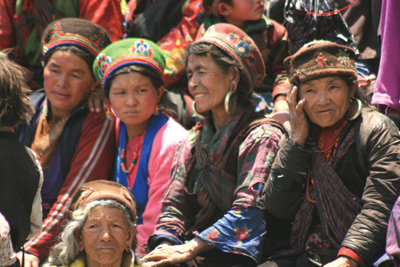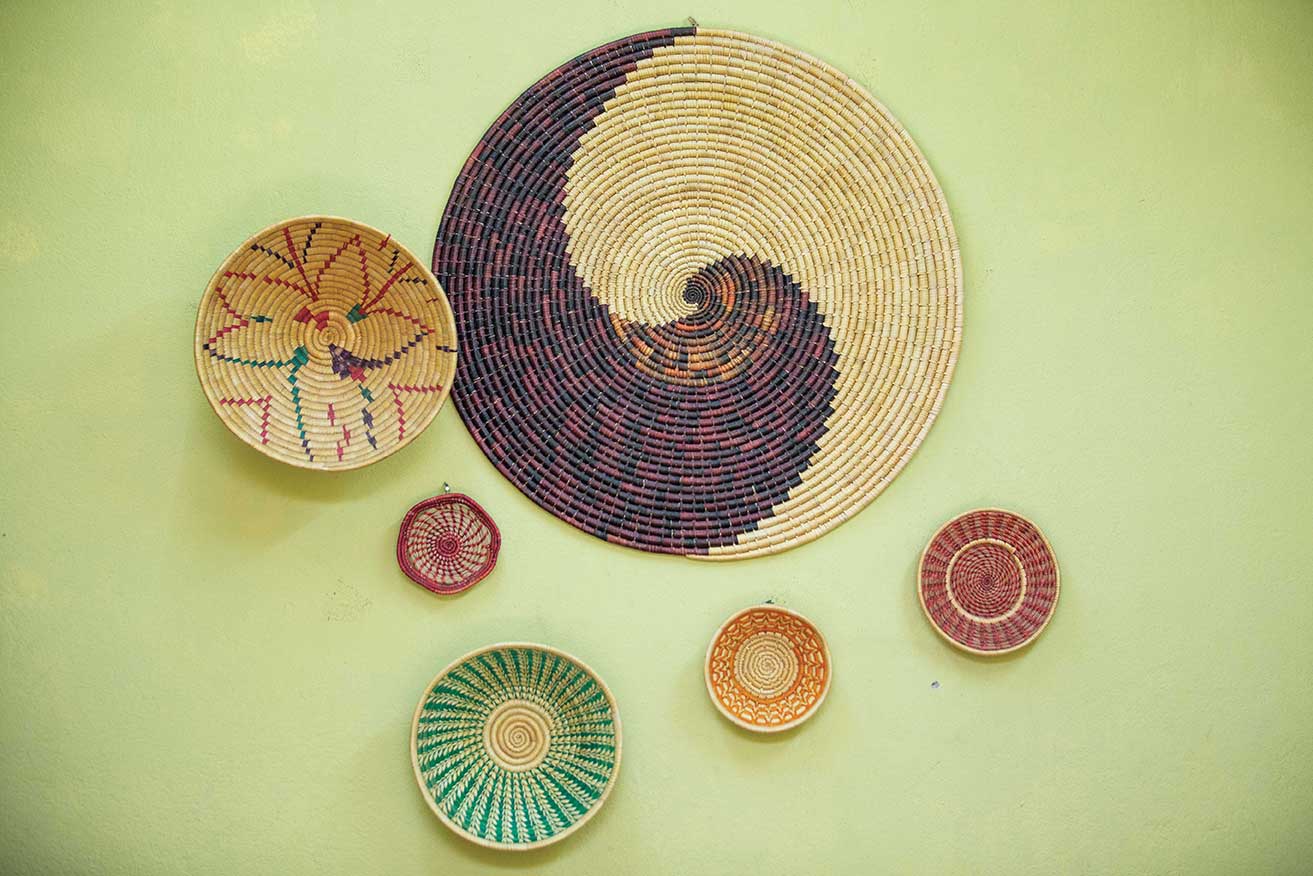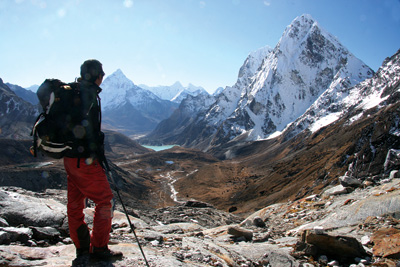 Oh my God, it’s simply unbelievable!” I first spoke these words when I trekked to Kanchenjunga in 1993 and I still speak them every time I venture back into the hills. But I’m still not quite sure what it is that so amazes and delights me every time I go trekking.
Oh my God, it’s simply unbelievable!” I first spoke these words when I trekked to Kanchenjunga in 1993 and I still speak them every time I venture back into the hills. But I’m still not quite sure what it is that so amazes and delights me every time I go trekking.
The greatest mountain scenery on the planet is a good start, but I know it is far, far more than that; it’s something about the people I meet when I’m in the Himalaya. It may sound a bit corny, but I think the Himalaya is where I became a man. Not in the Man vs Wild way, but where I learnt respect, tolerance, how to be part of a team and how to lead when things get tough. Basically, I learnt the sort of things you can’t learn in a classroom and that’s why I believe the mountains are somewhere for everyone, somewhere anyone can become a better person.
One of the real beauties of the Himalaya is that you don’t have to be a crazed mountain nut to enjoy them. The variety of places, people, terrain, seasons, ecology and history mean you can indulge almost any interest for as long or short as you like. Contrary to what many believe, there is always somewhere great to visit in Nepal at any time of year. The concept of ‘off and on-seasons’ has baffled me for years, especially as I often find the ‘off-season’ a much better time to head outdoors than the ‘on’. Yes, there are some activities that are somewhat season-specific but the timing and conditions of seasons varies a huge amount across Nepal, let alone the whole Himalaya. So, I find that first concentrating on the sort of experience I would like to have answers most questions about timing, destination, duration and difficulty.
I was sitting in a nomad’s tent in Upper Dolpo in late November. It was cold outside and my guide and I hadn’t eaten for many hours. Without talking the nomad lit some yak dung in a small brazier and placed a flat rock on top. As he began cooking buckwheat pancakes he smiled and said we looked hungry and that we should eat his pancakes with homemade chilli sauce. It was an experience I shall forever treasure, so simple and yet profound.
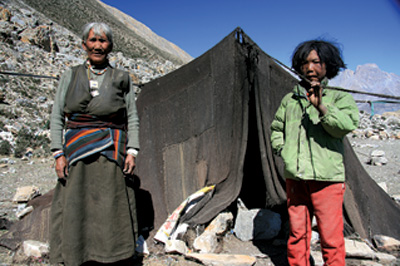 Whenever I have ventured beyond the tourist trails I immediately encounter an authenticity and hospitality that is beyond my comprehension. I would never be treated in the same tolerant, accepting way by a stranger in Australia and it makes immersing myself in the Himalaya even more delightful. I believe the best way to enjoy life is through participation because it means you have to share something of yourself. Trekking and spending time in the hills inevitably means you’ll be part of a stranger’s life and embraced by a world beyond your own. For me, the variety and diversity of the mountains is another strong drawcard. That by crossing a ridge you can enter another world of language, culture, traditions and beliefs is a constant reminder that no one opinion is absolute, there is always something new to learn around the next bend.
Whenever I have ventured beyond the tourist trails I immediately encounter an authenticity and hospitality that is beyond my comprehension. I would never be treated in the same tolerant, accepting way by a stranger in Australia and it makes immersing myself in the Himalaya even more delightful. I believe the best way to enjoy life is through participation because it means you have to share something of yourself. Trekking and spending time in the hills inevitably means you’ll be part of a stranger’s life and embraced by a world beyond your own. For me, the variety and diversity of the mountains is another strong drawcard. That by crossing a ridge you can enter another world of language, culture, traditions and beliefs is a constant reminder that no one opinion is absolute, there is always something new to learn around the next bend.
First Steps
Everyone has to start somewhere and my first Himalayan forays were simple and short. I began with a 5-day trek along the Singalila Ridge to the south of Kanchenjunga, a trip that was to inspire my love of the Himalaya. Each year I sought out slightly longer or more challenging treks to the Annapurna, Langtang and Khumbu regions. Without realising it I was building my confidence on the trail and what I now call field-craft or trekking wisdom.
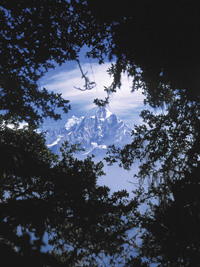 The weather had been bad for a couple of days, enclosing us in thick misty cloud. We stopped at the Nag Thali gompa on the Tamang Heritage Trail, the caretaker let us shelter beside his meagre fire. He made some tea and started playing haunting laments on a dramyin (Tibe tan guitar). After sharing some boiled potatoes he helped erect our tents. The following morning he woke us as the sun glinted off the top of sunken cloud that filled the valleys below. He seemed proud to share his mountain-island-world with us. Each time I’ve returned to Nag Thali we enjoy a cup of tea and sometimes he sings.
The weather had been bad for a couple of days, enclosing us in thick misty cloud. We stopped at the Nag Thali gompa on the Tamang Heritage Trail, the caretaker let us shelter beside his meagre fire. He made some tea and started playing haunting laments on a dramyin (Tibe tan guitar). After sharing some boiled potatoes he helped erect our tents. The following morning he woke us as the sun glinted off the top of sunken cloud that filled the valleys below. He seemed proud to share his mountain-island-world with us. Each time I’ve returned to Nag Thali we enjoy a cup of tea and sometimes he sings.
My time in the hills has gradually changed me. As I spend more time with my crew and locals I have developed new interests and am beginning to understand different perspectives. Inspired by the crew, I have found inner strength and my resilience and persistence when under stress has improved. When it comes to life-skills I am not a particularly fast learner, so it took me some time to understand that my character was changing for the better. Now, as I look back, I realise that youth and outdoor organisations around the world, from corporate team building to the Scouts, use the same principles.
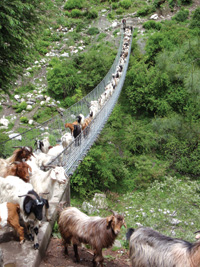 People of different abilities joined me on trips and it was a struggle at first to keep the group united. Sometimes the stronger walkers would disappear up the trail for hours at a time, or those with a cultural or religious interest would linger in villages and gompas. It took me a few attempts to teach people that by remaining together we ultimately get further and by enjoying the group experience we all benefit. When I then included both the trekking crew and the communities we were visiting in my overall group dynamic I began to see how responsible tourism really does work in the field. This has become one of the most important guiding principles of the Great Himalaya Trail, that often it’s not the ‘where’ but the ‘how you do things’ that matters most.
People of different abilities joined me on trips and it was a struggle at first to keep the group united. Sometimes the stronger walkers would disappear up the trail for hours at a time, or those with a cultural or religious interest would linger in villages and gompas. It took me a few attempts to teach people that by remaining together we ultimately get further and by enjoying the group experience we all benefit. When I then included both the trekking crew and the communities we were visiting in my overall group dynamic I began to see how responsible tourism really does work in the field. This has become one of the most important guiding principles of the Great Himalaya Trail, that often it’s not the ‘where’ but the ‘how you do things’ that matters most.
Rising to Challenges
Teahouse trekking along the most popular trails is both comfy and convenient, but it limits your experience and I longed to visit places untouched by tourism. I began by going to remote-r areas, like Rara Lake, the Ganesh Himal and the far-west of Nepal. To my surprise, the walking wasn’t any harder, and in many villages there were simple lodges and dhabas (eateries) that provided shelter and food as well as a more authentic feeling to my trips. They felt like the real Nepal I had been hoping to find.
In 2005, a wild trek between Upper Mugu and Upper Dolpo was far more physically challenging than I had bargained for but the extra effort and sense of accomplishment upon completion was amazing. Learning that we are normally only restricted by what we believe ourselves to be able to do and not what is actually possible has been the most fantastic discovery of my life... and it’s something I know is true for anyone!
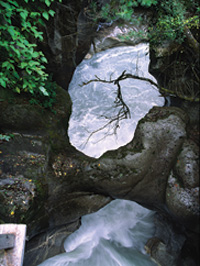 Researching and documenting the Great Himalaya Trail (GHT) has fulfilled many dreams and inspired many more. The physical difficulties have been considerable but maintaining motivation and a balanced perspective when the weather is against you or when the food runs out has been tougher. That’s why I think the concept of the GHT network is so powerful; anyone can design their own experience and level of challenge; there is no right or wrong, just whatever best suits you.
Researching and documenting the Great Himalaya Trail (GHT) has fulfilled many dreams and inspired many more. The physical difficulties have been considerable but maintaining motivation and a balanced perspective when the weather is against you or when the food runs out has been tougher. That’s why I think the concept of the GHT network is so powerful; anyone can design their own experience and level of challenge; there is no right or wrong, just whatever best suits you.
Standing on the high passes between Makalu and Everest was a highlight of exhilaration and relief. The effort, skill and teamwork needed to succeed is the same as running a successful enterprise anywhere, and of course, you have to make some of your own luck along the way. When I descended to the relative safety of Baruntse Base Camp I was overwhelmed by emotion and gratitude towards the team with me, without whom the GHT would still be a dream for me. It was then I realised how far I had come in my personal journey in the Himalaya and how far I was yet to go.
The things I have learnt about myself while trekking have become an integral part of my day to day life: the confidence to tackle new projects, the humility to ask for advice and guidance, the strength to shoulder responsibility and the motivation to push through tough times. Perhaps that is what so amazes and delights about trekking?
How to plan a trek?
The Experience – First, consider the sort of trekking experience you would like to have. Do you want a personal challenge in the mountains, or to immerse yourself in cultures, enjoy a festival or does a specific activity appeal? When you have a goal it will be easier to identify specific treks.
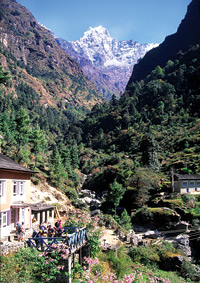 Time of Year – Then, think about the best time to get that sort of experience in the various regions of the Himalaya. Remember that altitude is often a limiting factor so make sure you consider mid-hills options, especially in the winter months.
Time of Year – Then, think about the best time to get that sort of experience in the various regions of the Himalaya. Remember that altitude is often a limiting factor so make sure you consider mid-hills options, especially in the winter months.
Trek Style – Many higher-altitude trekking regions are only accessible to camping trips, but in the Annapurna, Everest, Kanchenjunga, Manaslu, Helambu or Langtang regions teahouse-style treks are an attractive alternative. Local teahouses and dhabas are commonplace throughout lower altitude trips across the Himalaya. Trekking independently or with a guide and/or crew is an important consideration, see the table below for more information.
Trek Duration – The amount of time you can spend away from home is a major factor in deciding which trek to do; remember to leave yourself some buffer time before and after the trek in case of transport or weather delays.
Trek Grades – Finally, consider the trekking grades for your chosen region(s) and try to match your expectations of ‘life on the trail’ with the level of skill and commitment required. Make sure you consider the expectations and ability of everyone in your group, it’s never nice to drop people into the deep-end if they are just learning the ropes.
| Independent trekking without a guide | Teahouse trekking with a guide | Trekking with a camping crew | |
| Ideal destination | Annapurna, Everest, Helambu, Langtang. | Annapurna, Everest, Kanchenjunga, Langtang, Manaslu, Mustang. | Anywhere in Nepal. |
| Average number of days on the trail. | Up to a couple of weeks per trek |
One to three weeks per trek |
Two to four weeks per trek |
| Level of flexibility in your itinerary. | Good, you dictate your own pace. | Generally poor, but depends on group arrangements. | Generally poor, but depends on group arrangements. |
| Cost level | Low to Medium | Medium to High | Medium to High |
| Fitness/experience level | Need to be strong and fit to carry your gear. Prior experience advisable. | Training advisable but not with a heavy pack. Prior experience sometimes necessary. | Training and experience advisable depending on trek. |
| Amount of time to organise the trek in Kathmandu | Long – at least three days | Short – a few hours to 1 day | Medium – a couple of days |
Get trekking!
There are hundreds of trekking route permutations in Nepal and each has a distinctly different character as the seasons change. Here we provide an overview of some of the most popular introductory treks.
 1. Rara Lake and Khaptad National Parks
1. Rara Lake and Khaptad National Parks
In the far-west of Nepal are two of the countries smallest and post picturesque National Parks, Rara Lake and Khaptad. Both offer easy trails through an ideal mix of delightful villages and old-growth forests teeming with birdlife. For those with a little extra time join the two parks together by following an ancient trade route.
 Best time to visit: all year round, but best views November to April
Best time to visit: all year round, but best views November to April
Environment: sub-tropical to mid-hills
Trek style: local lodges, teahouses, homestays or camping
Duration: 5-16 days
Difficulty: easy to moderate trekking
Guidebook: Nepal: Trekking & the Great Himalaya Trail, Trailblazer, 2011
2. Phoksumdo Lake
Arguably the most stunningly beautiful lake in the Himalaya, Phoksumdo, lies on the border between Upper and Lower Dolpo. Combined with a trek over the Kagmara La and perhaps linking to Jumla, this whole region should be high on everyone’s bucket list.
Best time to visit: all year round but views are best October to May
Environment: mid to high Himalaya
Trek style: local lodges, teahouses, homestays or camping
Duration: 8-18 days
Difficulty: easy to moderate trekking
Guidebook: Nepal: Trekking & the Great Himalaya Trail, Trailblazer, 2011
3. Mustang Circuit
The ‘Forbidden Kingdom’ is a timeless place, where a vibrant traditional culture combines with the desolation of the Tibetan plateau. One of Nepal’s most impressive mountain festivals, Teeji, is held in Lo Manthang, Mustang’s capital on the ‘Plane of Aspirations’.
Best time to visit: March to November, but Teeji is around the May-June full moon
Environment: high Himalaya
Trek style: local lodges, teahouses, homestays or camping
Duration: 10 days
Difficulty: easy to moderate trekking
Guidebook: Nepal: Trekking & the Great Himalaya Trail, Trailblazer, 2011
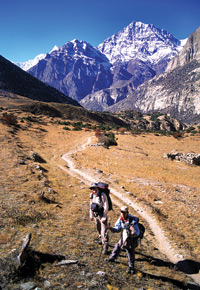 4. Annapurna Base Camp and Kopra Ridge
4. Annapurna Base Camp and Kopra Ridge
The trek to Annapurna Base Camp is along a classic trail that hasn’t suffered from over-development, and when combined with a side trip to the Kopra ridge is the equal of any trek in Nepal. Community and private lodges make this one of the most comfy treks around.
Best time to visit: all year round, but views are best November to March
Environment: mid to high Himalaya
Trek style: local lodges, teahouses, homestays or camping
Duration: 10-18 days
Difficulty: easy to moderate trekking
Guidebook: Nepal: Trekking & the Great Himalaya Trail, Trailblazer, 2011
 5. Naar and Phu
5. Naar and Phu
Get away from the crowds of the Annapurna Circuit by slipping between the near vertical gorge walls at Koto and into the valleys of Naar and Phu. You are guaranteed an authentic experience in these communities, which are proud of their traditions and heritage. Tackle the Kang La for unsurpassed Annapurna range views.
Best time to visit: March to December, best views October to December
Environment: mid to high Himalaya
Trek style: local lodges, teahouses, homestays or camping
Duration: 10-16 days
Difficulty: easy to moderate trekking
Guidebook: Nepal: Trekking & the Great Himalaya Trail, Trailblazer, 2011
6. Gurung Heritage Trail
Pretty villages with wonderful views of the Annapurna ranges and enjoy some enchanting Gurung hospitality. The trail is little used by trekkers, so you will have time to chat to the locals and hear tales of foreign service from the older fellows in town. Can connect with Annapurna Circuit or Base Camp trails.
Best time to visit: all year round, but best views in October to December
Environment: sub-tropical to mid-hills
Facilities: homestay, local lodges or teahouses
Duration: 4-5 days
Difficulty: easy to moderate
Guidebook: The Gurung Heritage Trail, Himalaya Map House, 2011
7. Manaslu Circuit and Tsum Valley
Perhaps the best general trek in Nepal, the Manaslu Circuit has dramatically increased in popularity over the last three years. Take your time and include a side trip to the intriguing Tsum valley, which still sees precious few trekkers despite opening in 2004.
Best time to visit: March to January, but views are best November-December or visit when the flowers are out in May-June
Environment: mid to high Himalaya
Trek style: local lodges, teahouses or camping
Duration: 10-20 days
Difficulty: easy to moderate trekking
Guidebook: Nepal: Trekking & the Great Himalaya Trail, Trailblazer, 2011
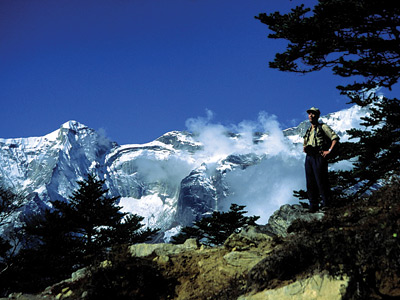 8. Chepang Hills
8. Chepang Hills
This is a great trek if you want to get away from it all and experience some sub-tropical trekking. The Chepang were nomadic hunter-gatherers who have now taken up a more settled life. Combine it with a trip to nearby Chitwan National Park for wildlife spotting.
Best time to visit: cool season from October to February
Environment: sub-tropical to mid-hills
Facilities: teahouses or homestays
Duration: 4-7days
Difficulty: easy
Guidebook: The Chitwan Chepang Hills Trail, Himalaya Map House, 2011
9. Tamang Heritage Trail
Just over 6-hours drive from Kathmandu, the Tamang Heritage Trail offers wonderful views, plentiful spring flowers, a large hot springs and the welcoming Tamang people. The THT is also home to many birds and animals, and has far less trekkers than the adjoining Langtang and Gosainkund treks.
Best time to visit: all year round, but best views in October to April
Environment: mid to high hills
Trek style: local lodges, teahouses, homestays or camping
Duration: 5-8 days
Difficulty: easy to moderate trekking
Guidebook: The Tamang Heritage Trail, Himalaya Map House, 2011
10. Gosainkund to Langtang Valley
Just to the north of the Kathmandu valley is the ancient pilgrimage route to Gosainkund lakes through the diverse Helambu region. The intermingling of Bhotia, Tamang, Brahmin, Newari and Chhetri people throughout the region is a wonderful example of Nepal’s harmonious ethnic diversity.
Best time to visit: all year round, but views are best October to January
Environment: mid to high Himalaya
Trek style: local lodges, teahouses, homestays or camping
Duration: 5-16 days
Difficulty: easy to moderate trekking
Guidebook: Nepal: Trekking & the Great Himalaya Trail, Trailblazer, 2011
11. Kathmandu Valley Rim
Excellent for short trips away from town, or when a bandha stops traffic. You can climb the Shivapuri Ridge for magnificent views of the valley below and the mountains beyond. Phulchowki and Shivapuri have some magnificent flowers to enjoy, all just a short distance from the city.
Best time to visit: Any time of year, but best views in October to April
Environment: sub-tropical to mid-hills
Facilities: local lodges, teahouses, homestays or camping
Duration: 3-7 days
Difficulty: easy
Guidebook: The Kathmandu Valley Rim and Beyond, Himalaya Map House, 2011
12. Bhairav Kund
One of Nepal’s stunningly beautiful sacred lakes, Bhairav Kund in the range above Kodari (Arniko Highway) is a must see! A pilgrimage site for both Hindus and Buddhists in monsoon, the reflection of Himalayan peaks touches the divine in all of us. Can be combined with a thrilling bungy jump as well!
Best time to visit: Any time of year, but views are clearest from November to May
Environment: mid-hills
Facilities: local lodges or camping
Duration: 4-6 days
Difficulty: moderate
Guidebook: Nepal: Trekking & the Great Himalaya Trail, Trailblazer, 2011
13. Indigenous Peoples Trail
This is a very culturally diverse trail that is rarely visited by any tourists. Boasting broad views of the Greater Himalaya to the north and welcoming communities of the most endangered ethnic groups of Nepal. This trek is a must for anyone interested in ancient cultures.
Best time to visit: all year round, but best views in October to December
Environment: sub-tropical to high hills
Facilities: local lodges, teahouses, homestays or camping
Duration: 5-7 days
Difficulty: easy
Guidebook: The Indigenous Peoples Trail, Himalaya Map House, 2011
14. Kanchenjunga Base Camp
Untouched eastern Nepal is dominated by the third highest mountain in the world, Kanchenjunga. A vast rhododendron, oak and pine forest surround the massif where Limbu, Rai and Sherpa communities live in near idyllic valleys. Expect some trails to be rough since the earthquakes in 2011.
Best time to visit: March to December, but views are best October to December
Environment: mid to high Himalaya
Trek style: local lodges, teahouses, homestays or camping
Duration: 18-32 days
Difficulty: moderate trekking
Guidebook: Nepal: Trekking & the Great Himalaya Trail, Trailblazer, 2011
Code of Conduct for Trekkers
Community
 Respect cultures and traditions
Respect cultures and traditions
Be a considerate guest, understand protocol, offer appropriate gifts when necessary, ask before taking a photo, do not show affection in public, and donations to gompas or shrines are appreciated.
Benefit local communities, commercially and socially
Share skills and experience, teach when you can, offer a fair pay for services, participate in activities. Do not encourage begging, publicly argue, drink excessively or fight.
Adopt new customs
Do not wear tight or revealing clothing, do not enter someone’s home unless invited, avoid touching people of the opposite sex, do not use your left hand to eat or pass objects and try to learn as much of the local language as possible.
Safety
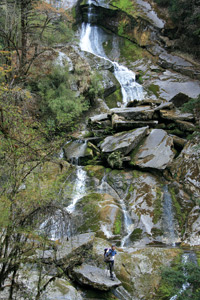 Beware of altitude sickness
Beware of altitude sickness
Use the buddy system to watch for symptoms of altitude sickness. Make sure everyone remains fully hydrated by drinking water throughout the day, everyday. Stay together along the trail, and communicate frequently with everyone.
Be Safe
Carry an extensive first-aid kit and know how to use it. Have multiple plans for emergency evacuation and designate decision makers. Leave your itinerary details with someone responsible at home. Beware of yaks and other animals on narrow trails!
Be self-reliant
Don’t assume you will receive help or assistance. Ensure your group has extensive field-craft and navigation skills. Research thoroughly, is your route appropriate for your party? Do you have the necessary skills, experience, resources and equipment?
Environment
Tread softly
Stick to trails and recognised camping areas. Avoid creating new tracks, or damaging the environment in any way. Follow the adage: take only photos and leave only footprints.
Pack it in, pack it out
Avoid taking tins, glass, or plastic containers and bags unless you plan to carry them back to a major town. Wash away from water sources, and always use local toilet facilities when available. Bury all organic waste at least 30cm below the ground and ideally 50m away from water sources.
Conserve natural resources
What few resources there are belong by right to the locals. Always ask permission before using anything along the trail. It is illegal to disturb wildlife, to remove animals or plants, or to buy wildlife products.


